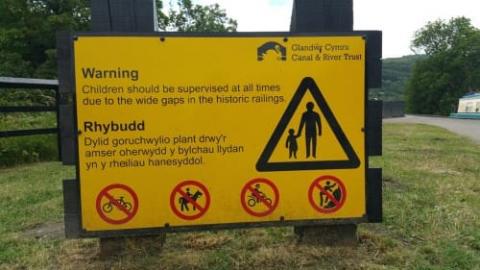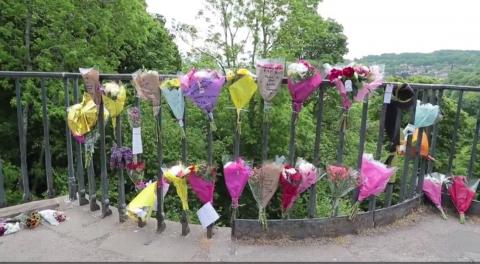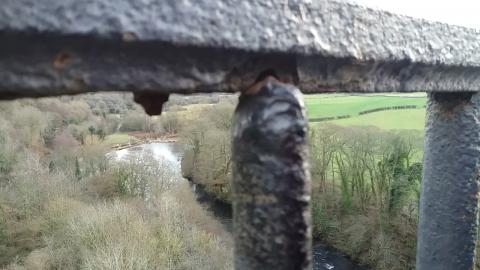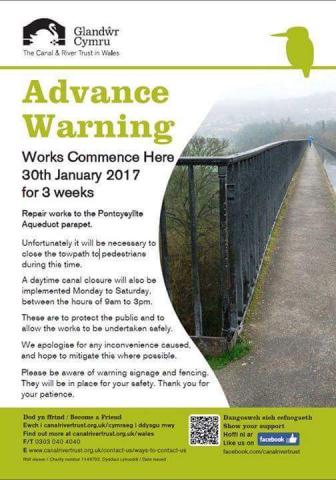C&RT threatened with criminal prosecution following Pontcysyllte death
January 2017 - Allan Richards investigates
The Health and Safety executive has confirmed that an ongoing investigation into one of the recent deaths at Pontcysyllte Aqueduct may result in criminal prosecution. On 31 May 2016, 18 year old Kris McDowell fell to his death from the World Heritage Site Aqueduct.
As exclusively reported in November 2016 Floater, an initial police investigation was quickly handed over to the Health & Safety Executive (HSE).
HSE found that a single upright from the parapet was dislodged at the site of the incident. As a result, HSE served an Improvement Notice indicating that the Trust had failed to take all reasonably practicable measures to ensure the safety of the railings.
HSE normally publishes its improvement notices on its website. However, in this case publication has not taken place because C&RT has appealed the notice. Whilst it was expected that the appeal might would have been heard by now, there is no report that it has taken place.
Similarly, there has been no further news of the inquest into Mr McDowell’s death which was opened in July but adjourned until October 2016 for a full hearing. The reason may be that both have been deferred pending the HSE investigation.
At the brief July hearing, John Gittins, coroner for North Wales East and Central, said that Kris McDowell had been identified by his driving licence and by his friend Matthew Breeze who had been crossing the aqueduct with him at the time of the incident. Provisional cause of death was given as chest trauma.
Mr Mcdowell’s death by falling from the aqueduct is not the only one to take place recently. Two months after Mr McDowells death, 24-year-old Benjamin Hughes died following a fall from the aqueduct. A final hearing has yet to take place. The same coroner also confirmed just days before Mr Mcdowells death that a third person, Darren Macfalane, aged 39, had died falling from the aqueduct.
In March 2015, chief executive Richard Parry told his board the Pontcysyllte Aqueduct has been identified as the only Trust location which could be regarded as a “suicide hot spot”. He added that discussions were ongoing with the local Samaritans group to explore options for suicide prevention support at the site.
Perhaps having forgotten what had been stated eighteen months before, C&RT’s board were again informed in September 2016 that, following the death of Benjamin Hall, the Trust were engaging with the Samaritans to support suicide prevention work at the aqueduct. Of course, discussions mentioned in March 2015 and again in September 2016 might be the same ongoing discussions. If this is the case, then why was this not made clear to the Trustees and an explanation given as to why action had not already been taken?
This is not the first time that C&RT have faced criminal prosecution. In 2012, the then C&RT Operations Manager, Vince Moran, admitted that a bridge where a 12 years old boy met his death was unsafe and was thus responsible for his death.
Robert Fidoe drowned attempting to ride his bike over a lock crossing that did not have a handrail. In a letter about such crossings, Vince Moran suggested the fact that Robert Fidoe was cycling across the bridge, despite signs to the contrary was immaterial. He stated: 'He could have been running, skateboarding, walking with shoelaces undone etc. It could have been a boater crossing who stumbled. It could have been a boater's grandchild helping out at the lock. The fact is that there was nothing for an individual to hold or grab.....' He added: ‘Whether there are similar accidents or near misses occurring is irrelevant in a situation where a young boy died and the risk to others is clearly foreseeable'
What Mr Moran did not say was that for years both C&RT and BW minimum safety standards had dictated that lock crossings should have hand rails. Furthermore, the absence of such handrails on many bridges in the area had been recorded as far back as 2009 with no action taken.
The Trust has recently been asked if HSE had told them it had sufficient evidence to bring a criminal prosecution following Robert Fidoe’s death but had decided that it was not in the public interest to do so. Jonathan Ludford, National Communications Manager, replied “It’s not something we wish to comment on”. Asked if the Trust made a case to HSE that it was not in the public interest to bring a public prosecution, he answered “No”. Asked again he replied “it didn’t”.
Warned that evidence existed to the contrary and again asked, he answered “I have spoken to Richard Parry [chief executive] and Tony Stammers [Head of Health and Safety] and, to the best of our knowledge, the Trust did not make a case to the HSE that it was not in the public interest to pursue a criminal prosecution. We’ve nothing further to add.” The email was copied to Mr Parry.
Following the three denials, Mr Ludford was referred to a board report written by Mr Parry’s predecessor, Robin Evans and published on C&RT’s website.
It states: “The Health and Safety Executive (HSE) have concluded their formal investigation into the death of the 13 year old boy who fell into a lock at Stourport when cycling across a lock tail bridge last summer. They conducted an interview under caution with the Head of Health and Safety [Tony Stammers]. It may be several months before we know how HSE intend to take this case forward and we have made the case that it would not be in the public interest for the Trust/BW to be prosecuted as we take our health and safety responsibilities extremely seriously and operate a proactive approach to safety improvement.”
Bearing in mind that Mr Stammers, at least, would have been well aware of the matter, one has to ask if the stream of continuous denials from Mr Ludford were based in ignorance or the apparently faulty memory of Mr Stammers? At the very least, Mr Stammers has made his chief executive look foolish by not informing him of what took place.
Despite admitting responsibility for the death, C&RT did escape criminal prosecution. Trustees were told in November 2013, more than two years after the death, that HSE had sufficient evidence to support a reasonable expectation of a successful criminal prosecution but had decided that this would not be in the public interest. Whilst enquires have been made of HSE, it is not currently known if the Trust’s request played a part in the decision not to prosecute.
Returning to Pontcysyllte, this is not the first time that the safety of the railings have been called into question. A complaint to HSE that children could squeeze through the railings did not lead to any alteration of the structure. This is in contrast with the Chirk Aqueduct where the railings have been modified to prevent this type of accident. Instead, large signs were erected at both ends of the aqueduct warning of the danger. The signs have a large pictograms showing an adult holding a Childs hand and smaller pictograms showing prohibited activities.
These include, no riding of motorcycles, bikes and horses. At the bottom right is a pictogram showing no climbing.
Whilst many of the deaths at Pontcysyllte are recorded as suicide, this is not thought to be the case with Kris McDowell. It is known that people climb on the Aqueduct and traverse it end to end on the outside of the railings or even on top of the railings. It is probable that Kris McDowell ignored a no climbing sign just as Robert Fidoe ignored a no cycling sign.
Whether he fell to his death because a railing became dislodged remains to be determined.









